
Boraginaceae, the borage or forget-me-notfamily, includes about 2,000 species of shrubs, trees, and herbs in 146 to 156 genera with a worldwide distribution.
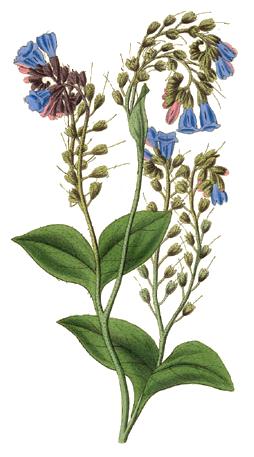
Symphytum is a genus of flowering plants in the borage family, Boraginaceae, known by the common name comfrey. There are 59 recognized species. Some species and hybrids, particularly S. officinale, Symphytum grandiflorum, and S. × uplandicum, are used in gardening and herbal medicine. They are not to be confused with Andersonglossum virginianum, known as wild comfrey, another member of the borage family.

Scheuchzeria palustris, is a flowering plant in the family Scheuchzeriaceae, in which there is only one species and Scheuchzeria is the only genus. In the APG II system it is placed in the order Alismatales of the monocots.

Karl Friedrich Schimper was a German botanist, naturalist and poet.

Arrhenatherum elatius is a species of flowering plant in the grass family Poaceae, commonly known as bulbous oat grass, false oat-grass, tall oat-grass, tall meadow oat, onion couch and tuber oat-grass. It is native to Europe, western Asia, and northern Africa. This bunchgrass is often used as an ornamental grass and is sometimes marketed as "cat grass".

Chaerophyllum is a genus of flowering plant in the family Apiaceae, with 35 species native to Europe, Asia, North America, and northern Africa. It includes the cultivated root vegetable Chaerophyllum bulbosum.

Symphytum asperum is a flowering plant of the genus Symphytum in the family Boraginaceae. Common names include rough comfrey and prickly comfrey. It is the tallest Symphytum species. It is native to Asia, and it is known in Europe and North America as an introduced species and sometimes a weed. Symphytum × uplandicum, the naturally occurring hybrid with the common comfrey, is the economically most important kind of comfrey.
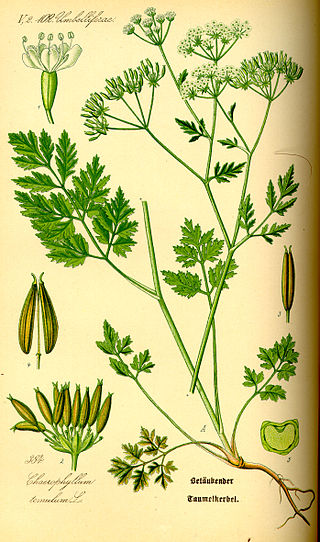
Chaerophyllum temulum, the rough chervil, is a species of flowering plant in the family Apiaceae.

Ethmia quadrillella is a moth belonging to the family Depressariidae, subfamily Ethmiinae.
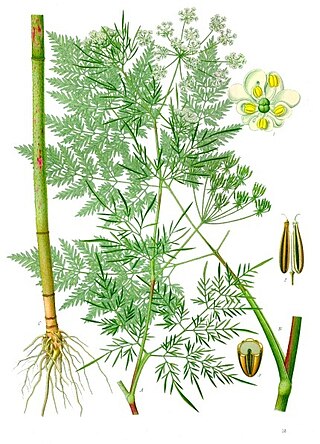
Chaerophyllum bulbosum is a species of flowering plant from the carrot family and known by several common names, including turnip-rooted chervil, tuberous-rooted chervil, bulbous chervil, and parsnip chervil. It is native to Europe and Western Asia. It was a popular vegetable in the 19th century.

Symphytum officinale is a perennial flowering plant in the family Boraginaceae. Along with thirty four other species of Symphytum, it is known as comfrey. To differentiate it from other members of the genus Symphytum, this species is known as common comfrey or true comfrey. Other English names include boneset, knitbone, consound, and slippery-root. It is native to Europe, growing in damp, grassy places. It is locally frequent throughout Ireland and Britain on river banks and ditches. It occurs elsewhere, including North America, as an introduced species and sometimes a weed. The flowers are mostly visited by bumblebees. Internal or long-term topical use of comfrey is discouraged due to its strong potential to cause liver toxicity.
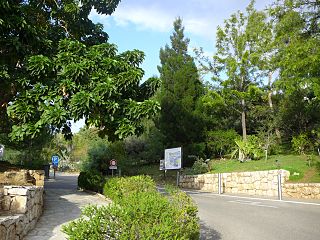
The Jardin botanique de la Ville de Nice, also known as the Jardin botanique de Nice, is a municipal botanical garden located at 78 avenue de la Corniche Fleurie, Nice, Alpes-Maritimes, Provence-Alpes-Côte d'Azur, France. It is open daily without charge.

Symphytum tuberosum, the tuberous comfrey, is a species of Symphytum in the family Boraginaceae.

Silene noctiflora is a species of flowering plant in the family Caryophyllaceae known by the common names night-flowering catchfly, nightflowering silene and clammy cockle. It is native to Eurasia, but it is known on other continents as an introduced species and sometimes a weed. In North America, it is a common weed of grain crops in the Canadian prairie provinces and in much of the United States. It grows in fields and in other disturbed habitat.

Russian comfrey or Quaker comfrey is a common hybrid between Symphytum officinale and S. asperum. It represents the economically most important kind of comfrey.
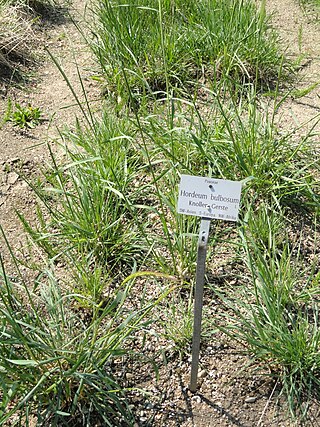
Hordeum bulbosum, bulbous barley, is a species of barley native to southern Europe, northern Africa, the Middle East and as far east as Afghanistan, with a few naturalized populations in North America, South America and Australia. Since 1970 it has been used in the Hordeum bulbosum Method to produce doubled haploid (DH) wheat and barley plants by crossing it with T. aestivum or H. vulgare, followed by the elimination of the H. bulbosum chromosomes from the offspring. These DH plants are important in breeding new varieties of wheat and barley, and in scientific studies. H. bulbosum is also being looked at as a source of genes for disease resistance and other traits for barley crop improvement.
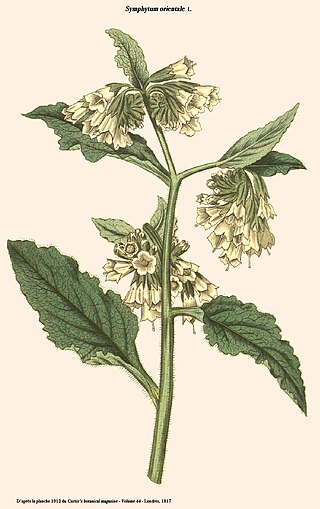
Symphytum orientale is a species of flowering plant belonging to the family Boraginaceae. It was first described in 1753 by Carl Linnaeus.
Andromonoecy is a breeding system of plant species in which male and hermaphrodite flowers are on the same plant. It is a monomorphic sexual system comparable with monoecy, gynomonoecy and trimonoecy. Andromonoecy is frequent among genera with zygomorphic flowers, however it is overall rare and occurs in less than 2% of plant species. Nonetheless the breeding system has gained interest among biologists in the study of sex expression.

Symphytum grandiflorum, the creeping comfrey, or running comfrey is a species of flowering plant in the family Boraginaceae. It is native to the Caucasus region, and introduced to various locales in Europe as a garden escapee. A deer-tolerant perennial, it is hardy in USDA zones 5 through 8, and is recommended for borders and shady situations. The unimproved species and a number of cultivars are commercially available. Also, it has been crossed with Russian comfrey to produce the multi-cross hybrid Hidcote comfrey, of which a range of ornamental cultivars are available.



















